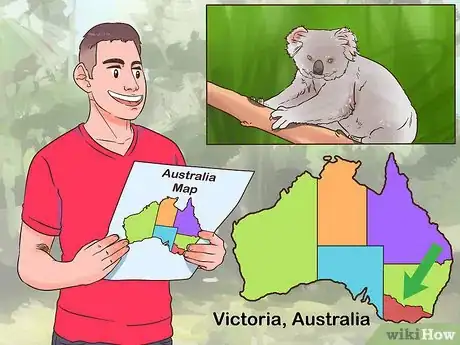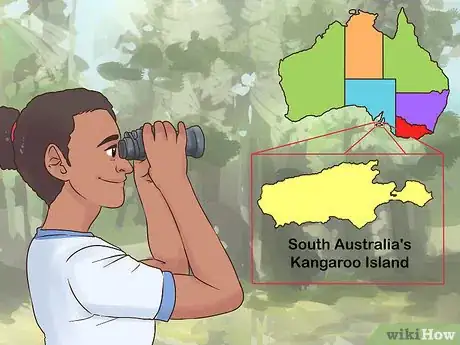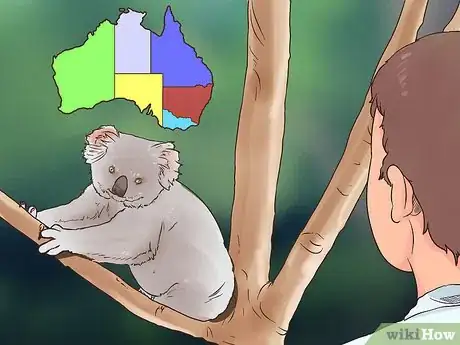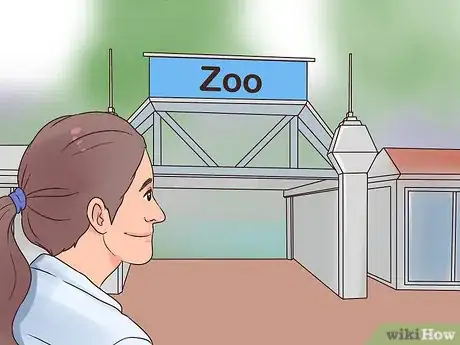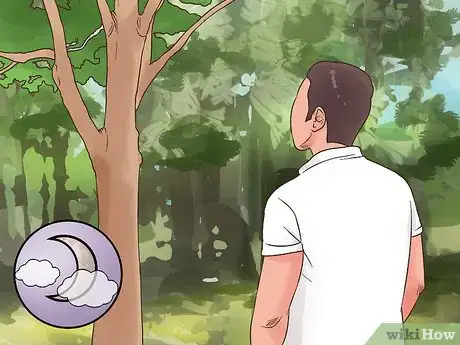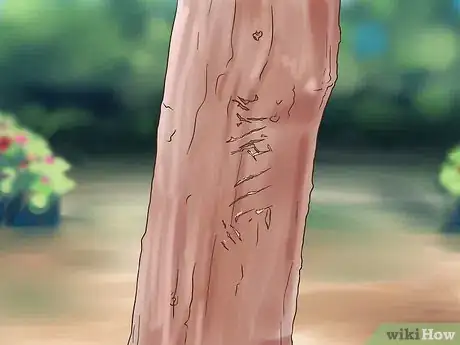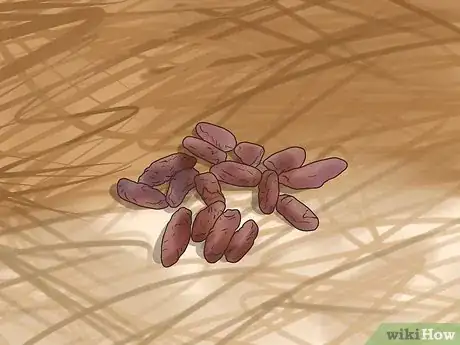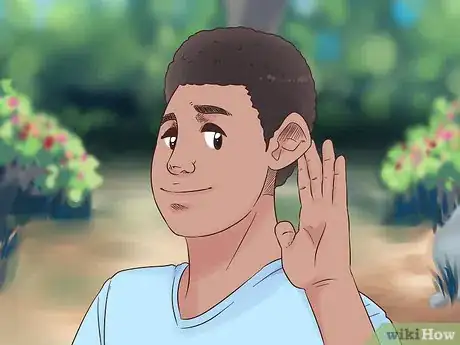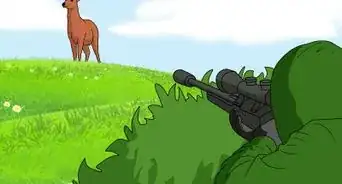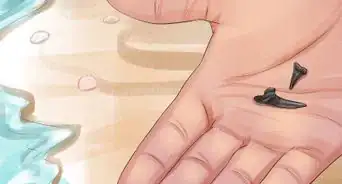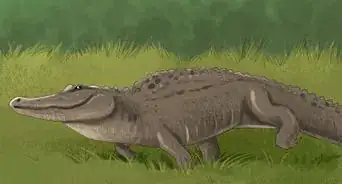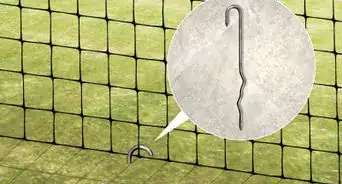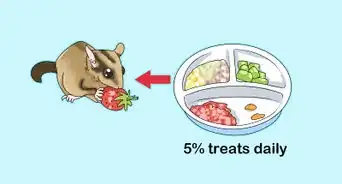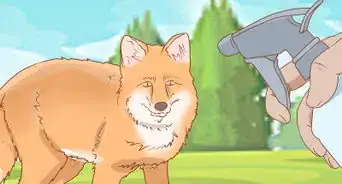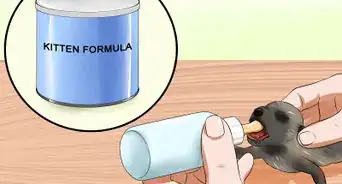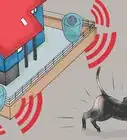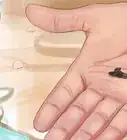This article was co-authored by wikiHow Staff. Our trained team of editors and researchers validate articles for accuracy and comprehensiveness. wikiHow's Content Management Team carefully monitors the work from our editorial staff to ensure that each article is backed by trusted research and meets our high quality standards.
There are 10 references cited in this article, which can be found at the bottom of the page.
This article has been viewed 15,414 times.
Learn more...
Koalas are notoriously shy and love to sleep, and can therefore be difficult to spot in their native habitat. Start by travelling to a state in Australia where they can be found in the wild. Look for them at night when they're at their most active and in eucalyptus tree forks where they love to rest, as well as for signs of their activity, such as tree scratchings, scat (poo), the smell of urine and mating calls.
Steps
Travelling to See Koalas
-
1Visit Victoria, Australia's koala capital. Victoria is one of the best states for finding koalas in the wild. Due to its wet and temperate climate, the koala population in this region has grown consistently over the last few years, in contrast to other states in Australia.
- Koalas are most likely to be found in Gippsland and on the Great Ocean Road in Victoria.[1]
- Raymond Island and the You Yangs are also popular destinations.
-
2See koalas and other wildlife on South Australia's Kangaroo Island. Kangaroo Island in South Australia is a hotspot for seeing koalas in the wild. Tens of thousands of koalas can be found on the island, along with wild birds such as the cockatoo and, of course, kangaroos.[2]Advertisement
-
3
-
4Travel to Queensland to see koalas. Noosa Headland National Park is a recommended option for seeing koalas in the wild in Queensland. The park helpfully provides a blackboard identifying where koalas have recently been sighted in the area.
-
5Go to a zoo, park or wildlife sanctuary if you can't see koalas in the wild. You can see koalas in captivity anywhere in Australia and your sighting will be virtually guaranteed. You may even have the chance to cuddle a koala and take close-up photos.
- You can cuddle a koala in Queensland, South Australia or Western Australia. [5]
- Zoos, sanctuaries and parks often act as centres of education and research for the protection of koalas. Viewing koalas in captivity can therefore act as a means of supporting their survival.[6]
- Recommended venues for seeing koalas in captivity include Lone Pine Koala Sanctuary in Brisbane; Tidbinbilla Nature Reserve in Canberra; Healesville Sanctuary in Melbourne and WILD LIFE on Hamilton Island.[7]
Looking for Signs of Koalas
-
1Try looking for koalas at night to see them at their most active. As nocturnal animals, koalas are most active at night and during dawn and dusk. If you decide to seek out koalas during the day, they will most likely be sleeping.[8]
-
2Look for koalas in the forks of eucalyptus trees. Koalas spend the bulk of their time eating or resting in eucalyptus trees, as this is where they source their food from.[9] You’ll need to scan the upper reaches of the branches to spot a koala in its natural habitat.
- Be sure to focus on the forks - due to their hard bottoms, koalas are able to rest comfortably in tree forks for long stretches at a time.[10] This means you are most likely to find them there.
- Koalas high up in a tree may be very difficult to see at first. Look for a small bump or round object on the tree.[11] Binoculars may help!
- You are most likely to see a koala sitting alone - they are quite solitary creatures and do not travel in packs like other animals.[12]
- Koalas can occasionally be found on the ground, when they are moving in between trees. If disturbed they may launch into a fast gallop until they reach the nearest tree.[13]
-
3Keep an eye out for koala scratchings on trees. If you see scratchings on the bark of a tree, these may be from koalas climbing up or down the tree and could suggest that a koala is nearby. Although these marks can be subtle, close attention should help you to identify them.
- Koala scratchings appear as two angled lines, located above smaller scratches and holes.[14]
- Koala scratchings are most commonly found on eucalyptus trees, but may be found on other trees as well.
-
4See if you can find koala scats (poo) at the bottom of eucalyptus trees. Koala poo is quite distinctive looking and a very good indicator that a koala is close at hand - particularly where the poo is fresh and there's a lot of it.[15] It is especially likely to be found at the bottom of eucalyptus trees.
- Koala poo is bullet-shaped and smells uniquely of eucalyptus.[16]
- The poos are approximately 2 centimetres (0.79 in) long and 0.5 centimetres (0.20 in) thick.
-
5See if you can smell koala urine. While unpleasant, the smell of koala urine may be very helpful in your quest to spot a koala - especially if it is fresh and potent, and located near a eucalyptus tree.
-
6Listen for koala mating calls during the summer season. During the summer months of December, January and February, male koalas will seek out female koalas within their home range to mate with. Both genders make distinctive mating calls during this time.
- Male koalas have a distinctive mating call, which sounds like a snore, followed by a loud, deep roar.
- Female koalas emit a similar call, but at a lower pitch.
- Koalas may also make squawking and wailing noises during intercourse.[19]
Warnings
- Koalas have been known to fall from trees due to loud disturbances, particularly caused by speeding cars. This can cause injury and even death. Be careful when driving in areas populated by koalas.[20]⧼thumbs_response⧽
- Be aware that koalas in the wild are wild - they are not familiar with and will not be friendly towards humans.[21] Best to observe them from afar.⧼thumbs_response⧽
References
- ↑ http://www.visitvictoria.com/Things-to-do/Nature-and-wildlife/Wildlife-and-zoos/Koalas
- ↑ http://wakingupwild.com/best-places-to-see-koalas-in-australia/
- ↑ https://www.walkmyworld.com.au/posts/best-places-to-see-wild-koalas-in-australia
- ↑ http://wakingupwild.com/best-places-to-see-koalas-in-australia/
- ↑ https://www.australia.com/en/things-to-do/nature-and-wildlife/where-to-snuggle-a-koala.html
- ↑ http://www.koalaland.com.au/single-post/2011/08/07/Koalas-in-Captivity
- ↑ http://wakingupwild.com/best-places-to-see-koalas-in-australia/
- ↑ https://www.ehp.qld.gov.au/wildlife/koalas/koala-ecology.html
- ↑ http://www.visitvictoria.com/Things-to-do/Nature-and-wildlife/Wildlife-and-zoos/Koalas
- ↑ https://www.ehp.qld.gov.au/wildlife/koalas/koala-ecology.html
- ↑ https://www.ehp.qld.gov.au/wildlife/koalas/koala-ecology.html
- ↑ https://www.savethekoala.com/about-koalas/frequently-asked-questions
- ↑ https://www.ehp.qld.gov.au/wildlife/koalas/koala-ecology.html
- ↑ http://root.ala.org.au/bdrs-core/gvkc/files/download.htm?className=au.com.gaiaresources.bdrs.model.file.ManagedFile&id=153163&fileName=Fact+Sheet_tips+on+how+to+spot+a+Koala.pdf
- ↑ https://www.ehp.qld.gov.au/wildlife/koalas/koala-ecology.html
- ↑ http://root.ala.org.au/bdrs-core/gvkc/files/download.htm?className=au.com.gaiaresources.bdrs.model.file.ManagedFile&id=153163&fileName=Fact+Sheet_tips+on+how+to+spot+a+Koala.pdf
- ↑ http://root.ala.org.au/bdrs-core/gvkc/files/download.htm?className=au.com.gaiaresources.bdrs.model.file.ManagedFile&id=153163&fileName=Fact+Sheet_tips+on+how+to+spot+a+Koala.pdf
- ↑ http://root.ala.org.au/bdrs-core/gvkc/files/download.htm?className=au.com.gaiaresources.bdrs.model.file.ManagedFile&id=153163&fileName=Fact+Sheet_tips+on+how+to+spot+a+Koala.pdf
- ↑ https://www.ehp.qld.gov.au/wildlife/koalas/koala-ecology.html
- ↑ http://www.visitvictoria.com/Things-to-do/Nature-and-wildlife/Wildlife-and-zoos/Koalas
- ↑ https://www.australia.com/en/things-to-do/nature-and-wildlife/australian-animals-the-koala.html
